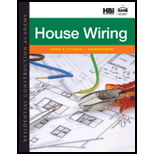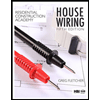
Concept explainers
In a work situation where an electrician’s hands get wet while operating a 120-volt, corded drill, which of the following would be true? (Objective 1-1)
a. Body resistance increases, and any shock would be mild.
b. Body resistance remains the same, and there is no danger as Long as rubber boots are worn.
c. Body resistance is substantially decreased, and severe shock could occur.
d. There is no danger as Long as a three-prong plug is used.
The true statement for the situation where an electrician’s hands get wet while operating a
Answer to Problem 1RQ
Option (c) Body resistance is substantially decreased, and severe shock could occur.
Explanation of Solution
Introduction:
According to the Ohm’s law, the relation between the current, voltage, and resistance is given by,
Here, the current is in amperes, voltage is in volts, and resistance is measured in Ohm’s.
The flow of current through any material depends upon the resistance provided by the material. The higher is the circuit resistance, the lower the current flow that a voltage can push through the circuit and vice-versa.
Dry skin offers much more resistance in comparison to the wet body. This means that higher the resistance value, the more opposition to the current flow through the body.
The following table shows the value of resistance with respect to the different conditions:
| Skin Condition | Resistance |
| Dry skin | |
| Sweaty hands | |
| In water |
As shown in the above table, the value of resistance for wet hands is very less so if in a work situation where an electrician’s hands get wet while operating a
As shown in the above table, the value of resistance for wet hands is very less, so the shock will not be mild. Thus, option (a) is incorrect.
Therefore, the body resistance will not remain the same if the hand gets wet. Thus, option (b) is incorrect.
The electrician will always be in danger if his hands are wet. Thus, option (d) is incorrect.
Conclusion:
Therefore, the Option (c) Body resistance is substantially decreased, and severe shock could occur is best suitable answer for the given statement.
Want to see more full solutions like this?
Chapter 1 Solutions
Residential Construction Academy: House Wiring (MindTap Course List)
- Note: Provide a clear, step-by-step, simplified handwritten solution (no explanations), ensuring it is completed without any AI involvement. The solution must demonstrate expert-level accuracy and will be evaluated for its quality and precision. Please refer to the provided image for additional clarity. Double-check all calculations for correctness before submission. Thank you!. Question 1: (refer to the image for visual understanding) For the soil element shown on the right: a) Draw the Mohr’s circle for this case b) Find the major and minor principal stresses c) Find the normal and shear stresses on plane AB. Question 2: (refer to the image) A soil sample in a triaxial test with a cell pressure of 100 kPa fails when the vertical stress reaches 400 kPa. The resulting failureplane is observed to dip 60 degrees from horizontal (see figure). Assume that the soil is drained during the test, i.e. there is no pore pressure. a) Determine the friction angle of the soil. Hint: draw the…arrow_forwardPlease solve all pointsarrow_forward1: find out the optimal solution: 1- Reliability Function 2- Serial Configuration 3- M.T.T.F 4- Probability distribution function (P.D.F) 5- Failure rate function :calculate the reliability of the system for the following Figure 0.90 0.80 0.95 0.80 0.80 0.94) 0.80 : A system containing four connected compounds in series, each one has a distribution and its parameters as shown in the table below Component Scale parameter Shape parameter 1 100 1.20 2 150 0.87 3 510 - 1.80 4 720 1.00arrow_forward
- Time: 1. Hrs During the last ten days: In one of the productive operations, the electronic control calculator equipped with No. of defects for a specific volume of samples as shown: 10 9 8 7 6 5 4 3 2 1 Day No. 6673 6976 7505 6991 7028 6960 7916 7010 6591 7350 Total No. 53 55 60 58 16 22 49 48 64 17 Defect No. DRAW THAT & CHOOSE THE BEST A-P chart. B-C chart 1. Key functions of quality control include: A) Control of design, materials received and products and conduct studies of operations B-Design and develop reasonable specifications C) The use of equipment that gives the required accuracy D) Provide appropriate screening equipment 2. The basic principles of critical pathways are: A-fragmentation of the system to the objectives of the secondary clear and specific B-Drawing the network diagram C-Finding the critical path D- All of the above 3- The production system is the following: A-An integral part of the plant's completion B-An effective system to integrate the efforts of various…arrow_forwardPlease solve all pointsarrow_forwardPlease solve all pointsarrow_forward
- Please solve the question by hand with a detailed explanation of the steps.arrow_forward) We started a new production process and its study gave the total deviations The standard value (for 25 samples of the product, sample size 4) is .105 .Calculate the capacity of this process The product specification limits are: 6.30 = LSL 6.50 = USL Standard deviation in a manufacturing system is 0.038 = We made improvements to the system and the deviation has become Standard 0.030 = σ What is required is to calculate the estimated coefficient before and after the operation Optimization. What is your conclusion? : A find out the optimal solution: 1-Average Outgoing Quality AOQ 2- operating Characteristics Curve 100% Inspection 3-Acceptable Quality level 4- Average outgoing Quality AOQ 5- Capability Index CPKarrow_forwardFollowing are the data of gauge and discharge collected at a particular section of the river by stream gauging operation. Gauge reading Discharge Gauge reading Discharge (m) (cms) (m) (cms) 7.65 15 8.48 170 7.70 30 8.98 400 7.77 57 9.30 600 7.80 39 9.50 800 7.90 60 89 10.50 1500 7.91 100 11.10 2000 8.08 150 11.70 2400 1. Develop a rating curve for this stream at this section for use in estimating the discharge for a known gauge reading and fit a linear regression equation for use in estimation of stage for a known value of discharge. Use a value of 7.50 as the gauge reading corresponding to zero discharge. (20 pts) Equation 1 arith 2. What is the coefficient of correlation of the derived relationship? (10 pts) R2² arith Equation 2 log R2 log 3. Determine the stage for a discharge of 3500 cms (5 pts) 4. Determine the discharge for a stage of 15 m (5 pts) NB Do both arithmetic and logarithmic plotsarrow_forward
- Q2/ A (2m x 4 m) rectangular flexible foundation is placed above the ground surface (G.S) for two layers of clay, each layer 10 m thick. The modulus of Elasticity (E.) of the upper layer is 13 MN/m² and that of the lower layer is 15 MN/m². The Poisson ratio is (u, = 0.6) for the two layers. The pressure (stress) of 100 kN/m²is distributed along the surface of foundation. Determine the rigid immediate settlement at the corner of the foundation using Elastic theory method?arrow_forwardQ1/ Find the maximum allowable load for a square foundation (3 m x 3 m) placed vertically in cohesive soil? (Use Terzaghi equation) Note: Yt=Yeat=18 kN/m³ Depth of foundation = 1.5 m Depth of water table below the ground surface = 0.8 m Factor of safety 3 C=20 Yw = 10 kN/m³ = No vertical or inclined loadsarrow_forwardP.3.3 Oil of sp.gr. 0.9 flows through a vertical pipe (upwards). Two points A and B one above the other 40 cm apart in a pipe are connected by a U-tube carrying mercury. If the difference of pressure between A and B is 0.2 kg/cm², 1- Find the reading of the manometer. 2- If the oil flows through a horizontal pipe, find the reading in manometer for the same difference in pressure between A and B. Ans. 1- R= 0.12913 m, 2- R = 0.1575 m,arrow_forward
 Residential Construction Academy: House Wiring (M...Civil EngineeringISBN:9781337402415Author:Gregory W FletcherPublisher:Cengage Learning
Residential Construction Academy: House Wiring (M...Civil EngineeringISBN:9781337402415Author:Gregory W FletcherPublisher:Cengage Learning Solid Waste EngineeringCivil EngineeringISBN:9781305635203Author:Worrell, William A.Publisher:Cengage Learning,
Solid Waste EngineeringCivil EngineeringISBN:9781305635203Author:Worrell, William A.Publisher:Cengage Learning,

